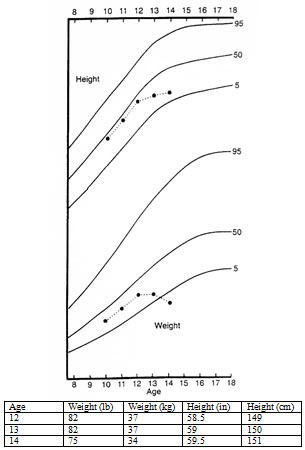Criteria
Diagnostic and statistical manual of mental disorders, 5th edition (DSM-5-TR)[1]
DSM-5-TR criteria for AN:
AN diagnostic criteria are as follows:
Restriction of energy intake relative to requirements leading to a significantly low weight in the context of age, sex, developmental trajectory, and physical health
Intense fear of gaining weight or persistent behavior that interferes with weight gain, even though at a significantly low weight
Disturbance in the way in which one's body weight or shape is experienced, undue influence of bodyweight or shape in self-evaluation, or persistent lack of the recognition of the seriousness of the current body weight.
Specific type:
Restricting subtype: no episodes of binge-eating or purging in the preceding 3 months; weight loss has been achieved by dieting, fasting, and/or excessive exercise
Binge-eating/purging subtype: recurrent episodes of binge-eating or purging in the preceding 3 months.
Severity specifiers are included in DSM-5-TR, based on the low weight categories identified by the World Health Organization. Identified severity at any weight may be increased based on clinical status, including vital sign or laboratory abnormality, and specific psychiatric symptoms, including suicidality.
Mild: BMI ≥17 kg/m²
Moderate: BMI 16-16.99 kg/m²
Severe: BMI 15-15.99 kg/m²
Extreme: BMI <15 kg/m².
Children and adolescents: there are additional challenges when determining whether or not a child or adolescent is underweight due to expected growth and developmental trajectories. Use of the US Centers for Disease Control and Prevention (CDC) BMI-for-age percentile is useful when examining a child's height and weight. The CDC has suggested that a BMI below the 5th percentile suggests underweight status, but often children and adolescents above the 5th percentile are significantly underweight, especially if prior to the eating disorder they had maintained a higher BMI-for-age percentile. Use of an individual growth chart is helpful in determining if the child is on his or her own personal growth trajectory. Younger patients who do not increase weight when growing in height, or do not make expected increases in height, may be demonstrating the low weight and low growth symptoms associated with AN.[80][Figure caption and citation for the preceding image starts]: Height and weight of a girl between the ages of 10 and 14.5 years, charted against age percentiles. She fell ill at 12 years of age and began losing weight. She was not diagnosed until 2 years later, at the age of 14. The weight loss was difficult to recognize by the physician as the patient did not gain in height over the 2-year period.From the personal collection of Pauline S. Powers [Citation ends]. [
Body Mass Index (BMI) percentiles for boys (2 to 20 years)
Opens in new window
]
[
Body Mass Index (BMI) percentiles for girls (2 to 20 years)
Opens in new window
]
[
Body Mass Index (BMI) percentiles for boys (2 to 20 years)
Opens in new window
]
[
Body Mass Index (BMI) percentiles for girls (2 to 20 years)
Opens in new window
]
ICD-11[2]
ICD-11 characterizes anorexia by significantly low body weight for the individual's height, age and developmental stage, not due to another health condition or to lack of available food. A BMI of less than 18.5 kg/m² in adults and BMI for age under the 5th percentile in children and adolescents. Rapid weight loss (e.g., more than 20% of total body weight within 6 months) may replace the guidance for low body weight when other diagnostic criteria are also met.[2]
Other required features for diagnosis include a persistent pattern of restrictive eating or behaviors that are aimed at achieving a low body weight including reducing energy intake, increasing energy expenditure through exercise or use of laxatives or vomiting. Also an excessive preoccupation with weight or shape, repeatedly weighing or measuring or avoiding tight clothing. Specifiers for underweight status are based on a lower BMI conferring a poorer prognosis and so divide into anorexia with normal body weight, with significantly low body weight or with dangerously low body weight.[2]
Use of this content is subject to our disclaimer